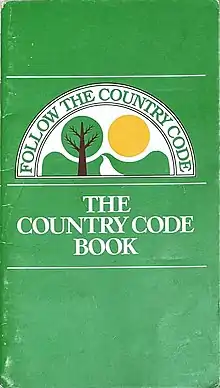The Country Code
The Country Code and The Countryside Code are sets of rules for visitors to rural, and especially agricultural, regions of the United Kingdom. The Country Code dates back to the 1930s and the Countryside Code replaced it in 2004.

The original rules
The Country Code evolved from the work of various organisations and had several different versions from the 1930s. The most widely accepted version of The Country Code was published in 1981 by the Countryside Commission:[1]
- Enjoy the countryside and respect its life and work
- Guard against all risk of fire
- Leave all gates as you found them
- Keep your pets under close control
- Keep to public paths across farmland
- Use gates and stiles to cross fences, hedges and walls
- Leave livestock, crops and machinery alone
- Take your litter home
- Help to keep all water clean
- Protect wildlife, plants and trees
- Take special care on country roads
- Make no unnecessary noise
In the 1960s and 70s the Country Code was publicised by several public information films shown in cinemas and on television.[2]
The Countryside Code
In 2004 The Country Code was revised and relaunched as The Countryside Code (Côd Cefn Gwlad in Welsh) to reflect the introduction of new open access rights and changes in society over the preceding years. The revised Code was produced through a partnership between the Countryside Agency and the Countryside Council for Wales
- Be safe - plan ahead and follow any signs
- Leave gates and property as you find them
- Protect plants and animals, and take your litter home
- Keep dogs under close control
- Consider other people
Covid-19 version
In early July 2020, the Westminster government published an amended short version of the code on-line during the COVID-19 pandemic as lockdown was being eased across England to help manage public access to the countryside under the changed circumstances.[3]
The Scottish Outdoor Access Code
In Scotland, where there is a more general right of access, Scottish Natural Heritage developed The Scottish Outdoor Access Code, which was approved in draft form by the Scottish Parliament in July 2003 following the passing of the Land Reform (Scotland) Act of the same year, and was accepted in February 2005. The Scottish Outdoor Access Code differs significantly from The Country Code in that it promotes access rights that include crossing over land and non-motorised recreational activities like walking, cycling, angling and horse riding, and will normally apply in all rural settings. The basis of access rights over land (in Scotland) is of shared responsibilities, in that those exercising such rights have to act responsibly, following the Scottish Outdoor Access Code, while land owners/managers have a reciprocal responsibility in respecting the interests of those who exercise their rights.[4]
The Scottish code "is based on three key principles [which] apply equally to the public and to land managers":[5]
- Take personal responsibility for your own actions.
- Respect people's privacy and peace of mind.
- Help land managers and others to work safely and effectively.
Three additional principles apply to visitors:[6]
- Care for your environment.
- Keep your dog under proper control.
- Take extra care if you are organising an event or running a business.
Both the Countryside Code and the Scottish code provide guidance for land managers as well as visitors.
See also
- Leave the gate as you found it, an international rural rule
- Leave No Trace
- Tread Lightly!
- Trail ethics
References
- "Follow the Country Code". Countryside Commission. 1997. Archived from the original on 8 January 1997.
- "Joe and Petunia: Acceptance of the Country Code". BFI Screenonline. Retrieved 13 January 2017.
- "The Countryside Code - short 'Covid-19' online version". Statutory guidance. Defra, Natural England. Retrieved 8 July 2020.
- "Scottish Outdoor Access Code". Scottish Natural Heritage. Retrieved 12 February 2018.
- "Scottish Outdoor Access Code" (PDF). Scottish Natural Heritage. 5 March 2014. See section 1.3.
- "Scottish Outdoor Access Code", pp.17–19
External links
- English Countryside Code Retrieved 13 January 2017
- Scottish Outdoor Access Code Retrieved 13 January 2017
- Welsh Countryside Code Retrieved 13 January 2017